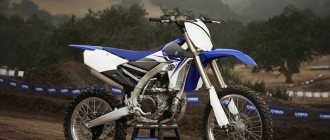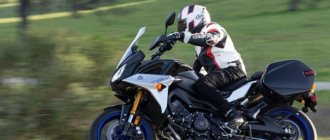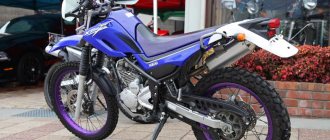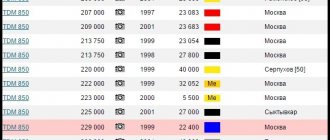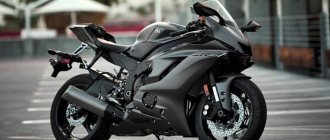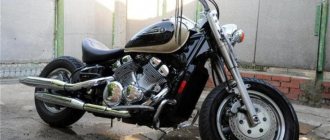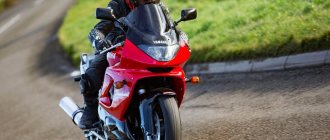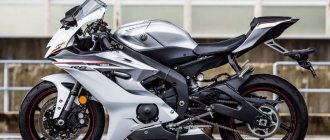The ideal motorcycle for a beginner is one that is not expensive and not too fast. Such a motorcycle is much easier to control in city conditions, it will not make sudden jerks and will be easier to control.
One of these is the Yamaha YBR 125 (EBR 125) motorcycle. Ebrik will help you learn to stay in the flow, change lanes and move between the rows, you will be able to enjoy driving motorcycles to the fullest. It was on this model that many novice motorcyclists grew up, who later switched to more powerful devices.
Is the Yamaha YBR-125 really the best small-capacity motorcycle?
RU-MOTO rating
Verdict
— The motorcycle has good technical characteristics and is quite playful. — Maximum speed 120 km per hour. Unfortunately, it will be unsafe to travel any longer. — Good build quality, allowing you to drive up to 10 thousand km without visiting a service station. - Cost-effective. Fuel consumption is 1.5 liters per 100 km with moderate driving. By filling the 12-liter tank, you can drive until exhausted. - Acceptable price. Indeed, compared to its competitors, Yamaha has the most optimal price/quality ratio.
Yamaha motorcycles have long been famous for their quality, performance and style. The motorcycle products produced are suitable for both beginners and extreme riding enthusiasts. The Yamaha YBR125 combines such qualities as reliability, unpretentiousness, maintainability and relatively low cost. Having a light weight and size allows you to move comfortably around the city and rough terrain. According to reviews from professionals, it is the best choice for a beginner.
Yamaha YBR125 - profile view
YBR125 is quite common in Russia and Ukraine. In 2010, the 4th generation of this series was released. The motorcycle is now equipped with an injector. Received some appearance changes with the addition of side plastic and a round headlight. Unfortunately, at the moment, the fourth generation is not supplied to Russia and Ukraine.
It copes with its functions wonderfully. It’s easy to quickly get from point A to point B through traffic jams. The high-spirited 125 cc engine allows you to accelerate to speeds of up to 120 km per hour. More is possible, but the engine will wear out.
As for gluttony, even the most economical engines will envy it. The Yamaha R125 consumes only 3 liters per 100 km during moderate driving and up to 4.5 liters when driving at high speeds. There is no need to prove that the motorcycle copes well with the function of quickly moving around the city and beyond, this is already obvious.
What tires are suitable for YBR 125
Until 2008, motorcycles had three-spoke wheels with tube tires. Since 2009, five-spoke wheels have been introduced for tubeless tires.
Standard tire sizes:
Tubeless tires are marked TL (tubeless), tube tires are marked TT (tube tire). Their difference lies in the presence or absence of a sealing layer. Tubeless tires can be used with a tube; on the contrary, with rare exceptions, you shouldn’t - air can leak through the tire itself. Many people try to install wider tires, however, this action is not entirely advisable, since it worsens handling, acceleration, reduces maximum speed and increases fuel consumption. The maximum possible tire size is listed below.
Maximum possible tire sizes:
Firstly, due to the greater mass of the wheel, dynamics are noticeably lost. Some people's top speed drops. There were cases when even 4.0 toothy tires were installed back. Secondly, factory performance characteristics are violated. The motorcycle rides a little differently. Thirdly, given that the mass of the motorcycle will not change, it will also continue to be thrown around on the cut asphalt. It will also bounce on bumps. In short, it’s not so much the tires that are to blame, but the mass. Fourthly, on good tires, the size of which will correspond to the factory values, you can easily load the motorcycle up to the pegs (provided that the asphalt is clean and the instinct of self-preservation is temporarily disabled or absent)
Which tires to choose?
Here are some tips for choosing tires:
OFF-ROAD TIRES Among the very inexpensive ones, models L-333, L-328, L-251, K-102 have also proven themselves very well. The quality of this rubber is not high, so it often has problems with balancing and is even visually crooked, although according to reviews they are now making it a little better. However, if you plan to drive faster than 80 kilometers per hour on asphalt, look at other options. Among the more expensive ones, models K-270 and K-760 are also praised.
RUBBER FOR ASPHALT The leader among manufacturers of rubber for motorcycles is the French company Michelin. For the YBR 125, their product line includes the "Pilot Street" and "Pilot Activ" models. At the time of writing (06.2017) it is very difficult to call some tires budget, and some premium, because after the rise in price of the dollar, a situation has arisen where the same Pirelli, which before the crisis was 2 times cheaper than Michelin, now costs twice as much expensive. The same is true with metzeller products. Their tires are very popular among owners of this motorcycle, namely the ME22 model. Despite the fact that it is positioned as tube rubber, it can be safely used without a tube. The ME77 model is also good, despite the retro-style tread pattern, it holds the motorcycle perfectly on dry and wet asphalt. Despite the fact that the YBR 125 is not the fastest motorcycle, it can still hydroplane, so always choose tires with a developed deep tread.
Source
YBR125 – a combination of the best characteristics?
The small-capacity single-cylinder engine of the Yamaha YBR 125 has a pleasant velvety sound, which is not annoying during long rides. Vibrations during operation are practically not felt - a definite plus.
Motorcycle Yamaha YBR125
As for the technical characteristics of the Yamaha YBR125, it has a vigorous four-stroke engine and a five-speed gearbox. The developers did their best and made the engine not only durable, but also fast, when compared with other motorcycles of a similar series from other companies. In addition, the fuel injection system was thoroughly developed. Now the YBR125 will not consume more than necessary, even if you are driving at the highest possible speed.
The motorcycle was transformed in detail and improved in the third generation. But there is no limit to perfection, and in the last, fourth generation, almost the entire appearance was radically redesigned. Also, the developers have worked on the chassis, which significantly increases the level of handling of the motorcycle. The suspension has been improved, making it softer and more comfortable.
Safety on this motorcycle has not been overlooked either. The creators of the Yamaha YBR 125 equipped the motorcycle with brake discs at the front and the usual drum brakes at the rear. Thanks to the brake disc, braking occurs smoothly and even in the most emergency situation, you can always brake safely and efficiently.
This motorcycle can be loaded with up to 200 kg (taking into account a full tank of gasoline), and a two-seater seat will allow the driver and passenger to move comfortably. Even if both have a weight of 90-100, the motorcycle will still cope perfectly with the goal.
Yamaha YBR125 - dashboard
On the third and fourth generations of YAMAHA YBR125, the dashboard is not left unattended. A convenient, laconic, but at the same time, informative device, which has everything that is so necessary.
Yamaha has been famous for its high-quality motorcycle products for more than 50 years. The YBR125 was made with love and care. High-quality driving without visiting a service station is guaranteed even after 10 thousand km.
What do people think?
According to the owners, the motorcycle in question is easy to maintain and operate; the engine does not have high power characteristics, but is reliable and works without interruption.
The operation of the gearbox is given good reviews and is rated as smooth. The vehicle is easy to drive and well suited for driving in traffic jams on the streets of a big city. When installing a minimal tuning kit, the ride becomes very comfortable and efficient.
People generally speak well of the motorcycle in question. He especially builds up novice drivers. They consider it reliable, modern, and also an easy means of transportation.
Previous entry The unique characteristics of the Yamaha R1 sportbike
Next entry Review of the BMW R1200GS motorcycle - technical specifications
YBR125 - owner reviews
Review of YBR125 from user Dilex from the portal moto.infocar.ua:
Screenshot of a review of the Yamaha YBR-125 motorcycle.
As for reviews, according to statistics, more than 80% of them are positive. Also, based on statistics, we can say that the motorcycle was least registered in various types of accidents, when compared, again, with competitors or other series of Yamaha motorcycle products. Here's an example:
001_MOTO_0910_034
It turned out that in order to prepare a dish that can satisfy the gastronomic needs of absolutely diverse and versatile people, ultra-modern technologies and exotic delights of famous restaurant chefs are not at all required. For most, the fundamental principle is still “cheap and cheerful.” How else can we explain that the simple and unpretentious “octagonal” Yamaha YBR125 sold in Europe alone with a circulation exceeding 75 thousand copies? And it’s impossible to count how many of them were sold in Asia and Latin America. Yes, yes, exactly Latin America. After all, the recipe for motorcycle “fast food” appeared in 2000 thanks to the Brazilian branch of the Yamaha Motor do Brasil corporation and was originally intended for the local Spanish- and Portuguese-speaking market: a two-valve single-shaft “single-barrel”, a simple steel frame, minimally sufficient brake mechanisms, simple suspension. Just what you need! The demand for the Yamaha YBR125 was so great that assembly of the model was also organized in Mexico and Colombia. And in 2003, they were joined by a joint venture with the Chinese company Jianshe Industries Co., Ltd in Southeast Asia. It was from there that the lion's share of these motorcycles subsequently came to Europe. It came to Russia even earlier than European countries - in 2004. In general, various modifications of the Yamaha YBR125 for different markets differ significantly from each other: place of production, plastic hitch, brakes, headlights, wheels, power systems. We were imported exclusively carburetor motorcycles from China with a rectangular headlight and a plastic half-fairing. These are what we will mainly be talking about.
011_MOTO_0910_034
POWER UNIT. A real success for Yamaha designers. The engine has been tested by time and barbaric operating conditions on the roads of the “third world”, and therefore has long been cured of most “childhood diseases”. The owners make up legends about its reliability and unpretentiousness, citing as weighty arguments the hundred and fifty thousand mileage and autonomous circumnavigation of some copies without major repairs. Needless to say, the engine consumes and easily digests almost any fuel and oil. If only the oil itself was changed at least once every 4,000 kilometers. At the same time, the oil-guzzling characteristic of some Yamaha models sometimes appears when the odometer exceeds 35 thousand kilometers, and disappears again with the replacement of piston rings and valve bushings. So it's no surprise that the YBR125 isn't the only bike in Yamaha Motors' slender line-up to use this engine. This list is impressive: XT125R/X, TT-R125, DT125RE, XTZ125E/XE. Some third-party manufacturers did not disdain the motor either (for example, Sherco CityCorp 125).
By the way, wide unification with Yamaha off-road models has one extremely positive side effect: for this engine there are several options for increasing the displacement from the standard 123.7 cm³ to a soul-warming 130–170 cm³. Similar tuning kits (for example, ProCycle, BBR Motorsports or Powroll) include a new cylinder-piston group, a camshaft with extended valve timing and sometimes even a crankshaft with an increased piston stroke. And in order to fully unleash the potential of the engine, you can at the same time install a new Keihin or Mikuni VM26 carburetor with a Ø26 mm diffuser and an engine control unit made by BBR Motorsports, which raises the upper limiter response zone by 1000 rpm. However, you will have to tinker with the release yourself, since the commercially available versions of complete systems for the TT-R125 or XT125R/X on the YBR125 will only fit at the point of attachment to the cylinder head. But the final result should be worth all the pain, because the engine will add about 5-7 “horses” to the existing ten. Some archaic design of the power unit is manifested in the requirement to inspect the thermal clearance of the valves every 6000 km. Neglecting service intervals leads to increased rattling noise from the cylinder head. But you shouldn’t be too afraid: the openness of access to the valves and the simplicity of the adjustment mechanism (screw - nut) make the already simple procedure elementary. But another characteristic noise from the cylinder head should alert you. Due to overheating, it may be necessary to replace crackling camshaft bearings. You can’t delay repairs - the “wedge” of the bearing and the subsequent meeting of the valves with the piston will cost many times more.
006_MOTO_0910_034
UPGRADES TABLE
| engine's type | 1-cylinder, 2-valve, 4-stroke, forward-leaning, air-cooled, SOHC |
| Volume | 124 cc cm |
| Bore and stroke | 54.0 mm x 54.0 mm |
| Compression ratio | 10.0 : 1 |
| Maximum power | 7.5 kW (10 hp) at 7800 rpm |
| Maximum torque | 9.6 Nm (0.98 kgf-m) at 6000 rpm |
| Lubrication system | Wet sump |
| Carburetor | Electronic fuel injection |
| Clutch type | Wet type, multi-disc with spring |
| Ignition system | Transistorized ignition system TCI |
| Starting system | Electric |
| Transmission system | Constant mesh, 5-speed |
| type of drive | Chain |
Specifications: Frame | |
| Frame | Diamond-shaped |
| Front suspension | Telescopic forks |
| Front suspension travel: | 120 mm |
| Rear suspension | monocross |
| Rear suspension travel | 105mm |
| Fork angle | 26º |
| Front brake | Hydraulic disc, Ø 245 mm |
| Rear brake | Drum, Ø 130 mm |
| Front tire size | 2.75-18 42P |
| Rear tire size | 90/90-18 M/C 57P |
text from Motorreview No. 11, 2005:
Mikhail Lapshin,
photo:
Dmitry Ivaikin
Yamaha YBR125: 123.7 cc, 12 hp, 110 km/h, $1990
April 28 – October 11, 2005, mileage
8500 km
For YBR, the past month of operation turned out to be difficult. I had to put a lot of kilometers on my wheels and be in the shoes of a motorcycle for beginners, and this is a double load.
I admit that when at the beginning of the season I decided to take the Chinese Yamaha for long-term testing, I thought that I would have to write a lot of negative things about the problems and breakdowns that arose. But in reality it turned out that there was nothing. After just a couple of months, I believed in him, like in any “Japanese”, which, as a rule, are created for driving, and not for tinkering with hardware. No matter how much you mocked the motorcycle (if you really want to, you can endurve it) on the motorcycle, no matter how much you abused the chassis (it happened that three of us rode together) and the engine (spin into the red zone happens often), but the YBR stoically withstood everything. The only thing is that the chain has stretched out a little (if I were the owners, I would have installed an o-ring here and forgotten about this unit), and the rubber bands of the footrests had become frayed. Agree, this is mere nonsense given such unbridled exploitation. And this month, new ones were added to the general permanent loads - the motorcycle played the role of a training bike for almost a week. Local boys, who had long looked after me with envy and hung out next to the garage, learned to ride it under my strict control.
Don't guess what I'm getting at? That's right! What do they teach in our motorcycle schools now? All the same ancient “Izhi” and “Kovrovtsy”. You can’t teach on something that essentially cannot move and is morally obsolete. I believe that very soon this entire fleet of motorcycles will be replaced by the YBR125. Firstly, for such schools the cost of the car is quite reasonable, and secondly, it is best to study on such a classic. I saw this with my own eyes. Almost all of my “students” who had initial skills in driving at least a bicycle, literally took off smoothly the second time and rode right away. Some even managed to change gears right away and brake quite confidently without any skidding or falling. The dimensions and weight of the Yamaha are such that any schoolchild can handle the motorcycle, and in the event of a fall (this has happened) practically nothing on the device is damaged, especially if the training is carried out on a grass field. According to many guys, control does not require much physical effort. And the engine thrust simply seemed like a rocket to them. But the main conclusion that I made for myself after this kind of master class for juniors is that Yamaha has a very positive effect on young people in terms of their further development of motorcycle preferences. For many, it was a real revelation that a motorcycle is not a dangerous bucket of nuts, but a thing that brings joy. The children have new guidelines. And the two oldest are already “terrorizing” their parents with all their might to buy this Yamaha. So on the YBR125, free entry into the motorcycle world is guaranteed.
As for me, a comparative test with a Kaliningrad classmate, and the mileage along the route Moscow - St. Petersburg - Moscow (read about this in the upcoming issues) once again confirmed confidence in the reliability and unpretentiousness of this budget model. It will definitely conquer the market.
Autumn, time to take stock of this amazing season. Why amazing? Editorial tests of the Chinese Yamaha turned even the most inveterate pessimists and skeptics into shining optimists.
I admit, I had absolutely no idea that the long-term tests of this budget foreign car would turn out to be so unexpected in terms of the final results and various promotions. Not only did the device have to put a lot of “ke-me” on its wheels under my leadership, but it was also in the skin of bait for motorcycle thieves, covered the route Moscow - St. Petersburg - Moscow paired with its Kaliningrad brother, and, most importantly , our employee managed to meet the Iron Butt standard on it... In any case, all this together led to a solid figure for the total mileage, and therefore to deeper and more balanced conclusions.
To the eternal question of the curious, “how’s the device?” I always answer confidently – excellent! Indeed, Yamaha can be given an “A” for the work done. Well, maybe with a small minus. I can already hear the angry roar of readers: “Yes, the R1 has a lot of minuses, but here this little guy gets the highest scores.” Yes, I bet. Naturally, with an eye on the class and market segment for which it is intended. Over the entire season, not a single incident happened to the car, much less a breakdown. Unless the clutch “ended” at the end of the season. However, the loads on this unit cannot be called normal, because the clutch was “tortured” by a whole team of boys when they were learning to ride a YBR, and then the device was also driven onto a cross-country track, then into the mud... In general, these are not at all normal conditions for road vehicles.
The high rating consists, first of all, of such qualities as efficiency, unpretentiousness, reliability, comfort, plus an amazingly low price. During normal use on highways and country roads, YBR consumes no more than 4 l/100 km. Moreover, changing fuel from AI-95 to AI-92 does not in any way affect the dynamics or operation of the power unit. If you drive slowly (80–90 km/h is cruising speed), then your appetite becomes even smaller. Oil consumption has not yet been observed, and this despite the fact that every now and then the engine had to be revved up to the red zone. At first I didn't like the brakes. But now I won’t be so categorical. There is no fuss, the effort can be measured clearly. What else does? Of course, emergency decelerations from “maximum speed” in traffic on the Moscow Ring Road, for example, did not become the best memories, but these are already quite extreme modes.
There are no questions about the power unit either. He rustles and rustles. In addition, in terms of access in case of repair or maintenance, everything is in full view here. A typical Yamaha “disease” - unclear operation of the gearbox - was also present at first. Now I can say that the patient is completely healthy - neutral is easily caught, shifting gears does not cause nervous twitching of the toe of the motorboat. Although size 45 is frankly a bit cramped on these footrests.
Finishing the conversation from the transmission, it is worth going through a unit such as a chain. It's a pity, it's a pity that she's just so ordinary here. No matter how you look after them, in our 8,500 km they have already replaced two. The O-ring would have lasted much longer. However, this would certainly lead to an increase in the price of the device. So advice to potential owners - as soon as the stock one is stretched to its limit, replace it with an O-ring chain.
From the outside, the light optics inspire respect, but in reality, the factory headlight settings only illuminate the clouds. Redirecting the light beam onto the road surface is not so easy. I had to disassemble the fairing and adjust the “angle of attack” of the diffuser. But this is the only time I had to adjust something on the motorcycle. Although I’m lying... Raising the idle speed with the adjusting screw on the carburetor is simply necessary - in the basic setting there is simply none.
The Russian road mentality has revealed several more nuances. The device looks quite presentable on the road (after all, the fact that it was decided to import the version with a mini-fairing was a wise decision), and it is not surprising that motorists are clearing the lane. But as soon as they realize what kind of miracle has overtaken them, the reverse process begins. Fortunately, any car can operate at speeds higher than the YBR, for which 120 km/h on the speedometer is the limit. The bicycle rear wheel especially let us down in terms of external aesthetics. A thicker “donut” just begs to come here.
There’s another problem in traffic jams – Yamaha drivers can’t hear! And this despite the fact that the “herring” nature of the motorcycle allows you to squeeze into gaps where even a person would have difficulty getting through. And there is a high probability of visiting some motorist if he happily opens the door, emptying out the ashtray. I can’t even resist advising to install a “direct flow”. Although…
So what happens? It must be said with all responsibility that the Russian motor market has finally received a budget product at the disposal of the masses with full compliance between price and quality. It is quite obvious that for that kind of money you cannot buy anything better new in Russia. And don’t forget that dealers offer excellent service, a guarantee and the possibility of purchasing on credit. With such an arrangement of stars in the sky, a bestseller is always born, and I will not be surprised that by the end of this year it is the Yamaha YBR125 that will break all sales records.
Into the dirt!
text:
Mikhail Lapshin,
photo:
Dmitry Ivaikin
Yamaha YBR125:
This time the device has only driven 700 km on its wheels, but what... Not many road motorcycles manage to experience the skin of a light enduro.
Tired of it! Frankly tired of making circles on the asphalt roads around the dacha, I looked for all the routes, went in the area even to places I didn’t want to go. Of course, the range of action was limited to a distance of no more than 100 km, but no one listed the YBR125 as a touring motorcycle. Long routes, as you understand, are tiring. Keeping the gas on full and seeing 120 km/h on the speedometer - not everyone can handle it. Especially when you are constantly being overtaken by cars. It's time to do something more exciting. And one fine day, instead of taking the usual route onto the nearest highway, I turned in the other direction, onto a path barely visible in the grass to the nearest forest. And already in the first meters of the journey, when I almost flew into an overgrown ravine, I realized that this activity was much more exciting than cutting across the asphalt.
I agree with the reader who at this point will mutter harmfully, saying, where are you going, the car is not intended for such purposes, it’s not intended to be broken... There are no objections, but haven’t any of you ever driven onto the ground on a road bike? And given the fact that the YBR125 is often bought as a vehicle for a summer residence, it is very likely that it will be used not only in civilian conditions. In general, this month Yamaha learned the routes of all forest paths, got used to jumping over fallen tree trunks, tasted all the delights of falling on soft grassy soil, and, of course, mud baths in numerous puddles.
There is only one conclusion – a collective farmer’s dream. The YBR125 easily digests the paths of the Russian outback. The soft suspension does not make it particularly difficult to handle small irregularities, such as roots protruding from the ground, and generally creates a feeling of comfort while driving. Only on large holes or bumps does the front telescope break through. I made the rear shock absorbers harder to make cornering on the gas more precise with slight wheel drift. The dry weight of the car is almost 100 kg, so you understand that even in difficult situations, when, for example, the path is blocked by a fallen tree, this “carcass” can be carried by hand. This same quality is good when crossing mud ravines or falling.
The standard tires are frankly not suitable for such operating modes. As soon as the soil swells a little from rain or heavy dew, a little braking with the front disc brake leads to the wheel skidding with a high probability of falling. The only thing that saves you in this situation is to have your legs pointed to the sides and a firm grip on the steering wheel - it’s not difficult to hold a light car at low speed.
By the way, in the wilderness I discovered another interesting quality of the device: the motor runs amazingly quietly. You can’t hear it even from a distance of ten meters, and sometimes it was surprising to find a hare or squirrel running away almost from under the wheels. That's what four-stroke means! The latter demonstrated decent elasticity, despite the modest working volume. In such conditions, only the second and third stages of the gearbox can be operated.
Super offer
text from Motorreview 2005:
Mikhail Lapshin,
photo:
Dmitry Ivaikin
Yamaha YBR125: 123.7 cm3, 12 l. pp., 100 km/h, $1990, April 28 - May 10, mileage 800 km
There is no doubt that the Japanese company Yamaha will soon become the most popular motorcycle brand in Russia. In this case, its main “combat unit” is the classic YBR125.
I admit, when I tested this model for the first time a year ago (“Motoreview” No. 6, 2004), I experienced ambivalent feelings about owning this motorcycle. On the one hand, I paid tribute to the wisdom of Japanese and, of course, Russian marketers who carried out such a correct and, I admit, at first somewhat unprofitable market move in terms of promoting this model. Just think: less than $2000 for a new foreign car, and even under the Yamaha brand! People, accustomed to the fact that “Japanese” cars cost well for $10,000, simply marveled at how this was possible. Yes, it is possible if you think globally about the sales market, and not see Russia as a country with no prospects in terms of the motorcycle business.
On the other hand, knowing the Russian mentality in terms of servility to large cubic capacity and power in the form of sportbikes with choppers, doubts crept in about the possibility of assimilation of this product under the name YBR125 in large quantities. But time has set its own accents. Last year, Russian Yamaha dealers sold a trial batch of these devices in the amount of 50 units instantly and received applications for almost ten times that amount. Therefore, this season the plans are generally Napoleonic - to implement 1000 cars. Actually, this fact served as the impetus for receiving YBR125 for long-term editorial testing. I would like to understand how the price corresponds to the build quality (the model is assembled in China on the official Yamaha assembly line), whether the device is reliable in terms of long-term operation, and in general, how successfully one can move around in the city and beyond. In general, there are a lot of questions and only seasonal tests can answer them.
From the outside, the YBR125 looks nice. And all thanks to the miniature half-fairing, which significantly updates the overall classic look. And the “two-glass” instrument panel with a dial indicator of the fuel level in the tank (a useful little thing!) significantly improves the first impression of the motorcycle. Not bad, very good. The Koreans and Chinese generally present a miserable package for that kind of money. And here there is even an electric starter. Of course, it’s stupid to think that now the device will “fly” like a “400”, but the first kilometers of the journey do not disappoint at all. Somehow your racing ambitions are immediately deflated, and the manner of driving motorists out of the lane by flashing your headlights is forgotten like a bad dream, and you begin to move sedately, moderately dynamically, along the two right lanes. Sometimes in these places you come across scooter riders who - thank God! - can't stand the competition. By the way, from the outside, only advanced motorcyclists are able to accurately determine the displacement of the engine, but if you stick a miniature YBR125 inscription under the saddle, you can easily pass off the model as a 250.
In first gear you can “squeeze out” 40 km/h, but at the same time the tachometer needle “grazes” almost in the red zone - 10,000 rpm. The engine groans and quickly loses traction at the top. Each subsequent gear to the red zone accelerates by another 20 km/h. So, you can easily reach 80 km/h, but to reach the maximum speed, 100 km/h according to the speedometer, you still need to accelerate and accelerate. Moreover, fifth gear is generally for driving downhill - the motorcycle practically does not accelerate in it. Well, unless, of course, the wind helps...
The pendants left a good impression. Since the device does not provoke extreme driving, you perceive their softness and comfort as a normal continuation of the general concept. It’s no secret what the capital’s roads look like in the spring, and it should be noted that it was only at the entrance to my dacha that I first began to think about what was under the wheels. The shock absorbers “eat up” potholes and broken seams in the asphalt perfectly. Naturally, the other side of the coin is the amorphousness and flimsiness of the chassis. This is especially noticeable during sudden lane changes and cornering. However, you shouldn’t ride the YBR125 with daring: the quieter you go, the further you will go.
These first hundreds of kilometers were driven mainly on country roads, driving along forest paths around the dacha and on dirt roads. I was pleased with the car. The YBR125 is definitely better than a scooter, and quieter in terms of power compared to used mid-sized Japanese ones. And obviously the still new appearance with a catchy inscription on the tank “Yamaha” inspires respect among the villagers. They are confident that it is at least a 500cc motorcycle. It’s a pity that you can’t get away from the annoying boys using straight-through chisels. During one of these competitions, a crazy idea came to my mind: what would happen to the YBR125 if you put an empty “muffler” on it? How much noise and respect! Well, I’ll tell you about this and other observations in the next report...
Parameters
Model _
| Yamaha YBR 125 | |
| Dry weight | 106 kg |
| dimensions | 1980´745´1050 mm |
| Base | 1290 mm |
| Seat height | 780 mm |
| Ground clearance | 175 mm |
| Gas tank volume | 13 l |
| Front fork tilt | n. d. |
| Engine | 123.7 cm3, 4-stroke, 1-cylinder, SOHC, 2-valve, air cooled |
| Engine size | 57/48.8 mm |
| Supply system | Mikuni carburetor |
| Compression ratio | 10,0 |
| Power | 12.5 l. With. at 8000 rpm |
| Torque | 9.5 Nm at 6500 rpm |
| Transmission | 5-speed gearbox, chain |
| Frame | steel, spinal |
| Front suspension | telescopic Æ30 mm, stroke - n. d. mm |
| Rear suspension | pendulum, two shock absorbers, stroke - n. d. mm |
| Front brake | one disc Æ150 mm, 1-piston caliper |
| Rear brake | drum |
| Front wheel | 2,75-18 |
| Rear wheel | 9,0/90-18 |
| Maximum speed | 100 km/h |
| Acceleration 0—100 km/h | 25 s |
| Fuel consumption | 3—5 l/100 km |


